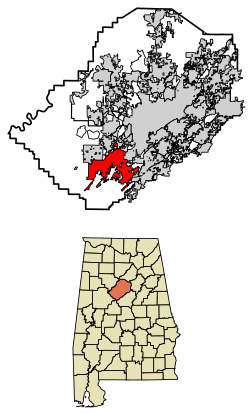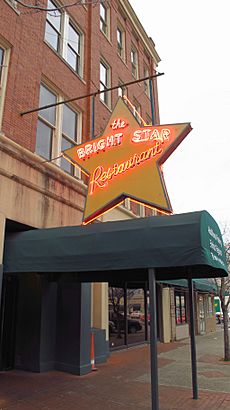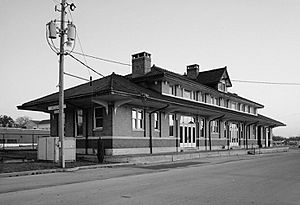Bessemer, Alabama facts for kids
Quick facts for kids
Bessemer, Alabama
|
|||
|---|---|---|---|

Jefferson County Courthouse in Bessemer
|
|||
|
|||
| Nickname(s):
The Marvel City
|
|||

Location of Bessemer in Jefferson County, Alabama
|
|||
| Country | United States | ||
| State | Alabama | ||
| County | Jefferson | ||
| Incorporated | August 27, 1887 | ||
| Area | |||
| • Total | 40.74 sq mi (105.51 km2) | ||
| • Land | 40.53 sq mi (104.96 km2) | ||
| • Water | 0.21 sq mi (0.55 km2) | ||
| Elevation | 509 ft (155 m) | ||
| Population
(2020)
|
|||
| • Total | 26,019 | ||
| • Estimate
(2022)
|
25,264 | ||
| • Density | 626.0/sq mi (241.7/km2) | ||
| Time zone | UTC−6 (Central (CST)) | ||
| • Summer (DST) | UTC−5 (CDT) | ||
| ZIP Codes |
35020, 35021, 35022, 35023, 35111
|
||
| Area code(s) | 205 and 659 | ||
| FIPS code | 01-05980 | ||
| GNIS feature ID | 2403864 | ||
| Sales tax | 10.0% | ||
Bessemer is a city in Jefferson County, Alabama, United States and a southwestern suburb of Birmingham. The population was 26,019 at the 2020 census. It is within the Birmingham-Hoover, AL Metropolitan Statistical Area, of which Jefferson County is the center. It developed rapidly as an industrial city in the late 19th and early 20th centuries.
Contents
History
The town was founded in the Reconstruction Era by the Bessemer Land and Improvement Company, named after Henry Bessemer and owned by coal magnate Henry F. DeBardeleben. He had inherited Daniel Pratt's investments. The mayor and councilmen voted to incorporate the city of Bessemer on September 9, 1887. Located 16 miles southwest of Birmingham, Bessemer grew rapidly and its promoters believed that it might overtake the other city in economic power.
Given the iron ore, coal and limestone deposits in the area, the city became a center of steelmaking from about 1890 through the 20th century. It attracted rural migrants from across the South, as well as European immigrants. By the 1950s, the city was majority African American in population.
The industry went through considerable restructuring in the late 20th century, and jobs moved out of the area. Steel is no longer made there.
In 2019, it was named Alabama's "Worst City to Live in" by 24/7 Wall Street.
Geography
Bessemer is located approximately 16 miles (26 km) southwest of Birmingham.
According to the United States Census Bureau, the city has a total area of 40.74 square miles (105.5 km2), of which 40.53 square miles (105.0 km2) is land and 0.55 square miles (1.4 km2) (0.55%) is water.
Bessemer is situated in the midst of the iron ore and limestone district of Alabama, in the southern part of Jones Valley (about 3 miles (4.8 km) wide). Iron ore was mined on the hills on the city's southeast side, coal was, and still is mined to the north and west, and limestone deposits were also nearby. All three ingredients were necessary for steelmaking, which led to the area becoming a major steel center from about 1890 through the twentieth century. Steel is no longer made within the city limits but is still manufactured in the neighboring city of Fairfield.
Climate
The climate in this area is characterized by hot, humid summers and generally mild to cool winters. Bessemer has a humid subtropical climate, abbreviated "Cfa" on climate maps, within the Köppen Climate Classification system.
| Climate data for Bessemer, Alabama (1991–2020 normals, extremes 1977–present) | |||||||||||||
|---|---|---|---|---|---|---|---|---|---|---|---|---|---|
| Month | Jan | Feb | Mar | Apr | May | Jun | Jul | Aug | Sep | Oct | Nov | Dec | Year |
| Record high °F (°C) | 79 (26) |
89 (32) |
90 (32) |
98 (37) |
102 (39) |
105 (41) |
108 (42) |
109 (43) |
103 (39) |
102 (39) |
90 (32) |
88 (31) |
109 (43) |
| Mean maximum °F (°C) | 72.4 (22.4) |
76.2 (24.6) |
82.4 (28.0) |
86.4 (30.2) |
91.9 (33.3) |
96.8 (36.0) |
98.1 (36.7) |
98.8 (37.1) |
95.6 (35.3) |
89.1 (31.7) |
80.3 (26.8) |
73.2 (22.9) |
100.2 (37.9) |
| Mean daily maximum °F (°C) | 55.7 (13.2) |
60.6 (15.9) |
68.3 (20.2) |
76.0 (24.4) |
83.0 (28.3) |
89.1 (31.7) |
91.8 (33.2) |
91.7 (33.2) |
87.1 (30.6) |
77.1 (25.1) |
66.0 (18.9) |
57.9 (14.4) |
75.4 (24.1) |
| Daily mean °F (°C) | 44.8 (7.1) |
48.8 (9.3) |
55.8 (13.2) |
63.1 (17.3) |
71.2 (21.8) |
77.9 (25.5) |
81.2 (27.3) |
80.6 (27.0) |
75.4 (24.1) |
64.8 (18.2) |
53.8 (12.1) |
47.3 (8.5) |
63.7 (17.6) |
| Mean daily minimum °F (°C) | 33.8 (1.0) |
37.0 (2.8) |
43.3 (6.3) |
50.1 (10.1) |
59.4 (15.2) |
66.7 (19.3) |
70.5 (21.4) |
69.6 (20.9) |
63.8 (17.7) |
52.6 (11.4) |
41.5 (5.3) |
36.7 (2.6) |
52.1 (11.2) |
| Mean minimum °F (°C) | 15.7 (−9.1) |
19.7 (−6.8) |
25.2 (−3.8) |
33.5 (0.8) |
43.5 (6.4) |
55.0 (12.8) |
61.4 (16.3) |
59.6 (15.3) |
47.9 (8.8) |
34.3 (1.3) |
24.4 (−4.2) |
20.8 (−6.2) |
13.5 (−10.3) |
| Record low °F (°C) | −6 (−21) |
3 (−16) |
6 (−14) |
15 (−9) |
36 (2) |
43 (6) |
52 (11) |
47 (8) |
37 (3) |
21 (−6) |
16 (−9) |
−1 (−18) |
−6 (−21) |
| Average precipitation inches (mm) | 5.40 (137) |
5.38 (137) |
5.42 (138) |
5.11 (130) |
4.55 (116) |
4.53 (115) |
4.76 (121) |
3.98 (101) |
3.45 (88) |
3.26 (83) |
4.45 (113) |
5.20 (132) |
55.49 (1,409) |
| Average snowfall inches (cm) | 0.4 (1.0) |
0.0 (0.0) |
0.7 (1.8) |
0.0 (0.0) |
0.0 (0.0) |
0.0 (0.0) |
0.0 (0.0) |
0.0 (0.0) |
0.0 (0.0) |
0.0 (0.0) |
0.0 (0.0) |
0.1 (0.25) |
1.2 (3.0) |
| Average precipitation days (≥ 0.01 in) | 10.4 | 10.7 | 10.9 | 9.3 | 8.5 | 10.5 | 10.9 | 9.9 | 6.4 | 6.7 | 8.2 | 10.8 | 113.2 |
| Average snowy days (≥ 0.1 in) | 0.1 | 0.0 | 0.1 | 0.0 | 0.0 | 0.0 | 0.0 | 0.0 | 0.0 | 0.0 | 0.0 | 0.0 | 0.2 |
| Source: NOAA | |||||||||||||
Demographics
| Historical population | |||
|---|---|---|---|
| Census | Pop. | %± | |
| 1890 | 4,544 | — | |
| 1900 | 6,358 | 39.9% | |
| 1910 | 10,864 | 70.9% | |
| 1920 | 18,674 | 71.9% | |
| 1930 | 20,721 | 11.0% | |
| 1940 | 22,826 | 10.2% | |
| 1950 | 28,445 | 24.6% | |
| 1960 | 33,054 | 16.2% | |
| 1970 | 33,663 | 1.8% | |
| 1980 | 31,729 | −5.7% | |
| 1990 | 33,497 | 5.6% | |
| 2000 | 29,672 | −11.4% | |
| 2010 | 27,456 | −7.5% | |
| 2020 | 26,019 | −5.2% | |
| 2022 (est.) | 25,264 | −8.0% | |
| U.S. Decennial Census 2020 Census |
|||
2020 census
| Race | Number | Percent |
|---|---|---|
| White (non-Hispanic) | 4,877 | 18.74% |
| Black or African American (non-Hispanic) | 18,107 | 69.59% |
| Native American | 48 | 0.18% |
| Asian | 68 | 0.26% |
| Pacific Islander | 5 | 0.02% |
| Other/Mixed | 609 | 2.34% |
| Hispanic or Latino | 2,305 | 8.86% |
As of the 2020 census, there were 26,019 people, 10,492 households, and 6,378 families residing in the city.
2013 ACS
In the 2013 American Community Survey, there were 27,336 people living in the city. 72.0% were African American, 24.0% White, 0.1% Native American, 0.2% Asian, 0.1% from some other race and 0.4% from two or more races. 3.2% were Hispanic or Latino of any race.
Economy
In 1900, Bessemer ranked eighth in the population in Alabama, second in the amount of capital invested in manufacturing, and fourth in the value of its manufactured product for the year. By 1911, ore mining, iron smelting, and the manufacture of iron and coke were the chief industries of Bessemer. Truck farming was an important industry, dating from the area's agricultural past.
Both blacks and whites from rural areas were attracted to the city for its new work opportunities. Gradually African Americans moved into industrial jobs and became part of integrated unions. Such jobs enabled many working-class families to enjoy middle-class incomes.
Today, ore mining has ended, as supplies were exhausted. Manufacturing remains a factor, with the U.S. Pipe and Foundry ductile pipe plant on the city's north side. In May 2007, U.S. Pipe announced that it would be building a new $45-million foundry near the current plant. The site was selected, among other reasons, for having available space for potential future expansions. U.S. Pipe is the largest domestic producer of Ductile Iron pipe in sizes 4 inch through 64 inch.
Bessemer was once home to a large railroad car manufacturing factory, operated by Pullman Standard for many decades and later by Trinity Industries. With railroad restructuring in the late 20th century and other manufacturing moving offshore, this plant ceased most production in the 1990s. In 2012, BLOX LLC (bloxbuilt.com) a manufacturer of modular components for healthcare facilities moved into this facility.
The decline of mining and exodus of the steelmaking and railcar manufacturing industries resulted in extensive loss of jobs. Bessemer has lost population since a peak population in 1970. It faced an economic crisis in the early to mid-1980s, as unemployed workers constituted more than one-third of the workforce. Since that time the city has been successful in diversifying its economy, through the efforts of the Bessemer Area Chamber of Commerce and the Bessemer Industrial Development Board. It is recognized for its business growth. In June 2018, Amazon announced that it would build a new 800,000 square feet (74,000 m2), $325 million fulfillment center in Bessemer, which will initially create 1,500 new jobs.
Arts and culture
The performance center Bessemer Civic Center provides multiple performance spaces for music and theatre.
Education
Public schools
Bessemer has its own school system independent of Jefferson County schools, Bessemer City School District. The system includes:
- Hard Elementary
- Jonesboro Elementary
- Greenwood Elementary
- Abrams Elementary
- Westhills Elementary
- Bessemer City Middle
- Bessemer City High School (formally Jess Lanier)
The Board of Education also operates the Quitman Mitchell Opportunity Center, which includes an adult learning center, Even Start child care center, and New Horizon Alternative School.
Private schools
K–12 private schools in the Bessemer include Rock Christian School and Bessemer Academy, which was founded as a segregation academy.
Community college
Lawson State Community College operates the former Bessemer Technical College campus. The two schools merged in 2005 as a cost-saving measure.
Media
The Western Star is a weekly newspaper which covers Bessemer and nearby communities.
The Birmingham News is published three days per week, and also publishes a weekly section devoted to news from Bessemer and nearby communities.
One radio station, WZGX (1450 AM), operates within the city; it broadcasts some Spanish-language programming and music to appeal to the growing Mexican-American population of Jefferson County. It also continues a tradition of broadcasting high school football games on Friday nights. All of metro Birmingham's stations are heard in Bessemer, as well as several stations broadcasting from Tuscaloosa.
Television station WDBB (channel 17) is licensed to Bessemer, but broadcasts from studios in Birmingham, simulcasting with WTTO (channel 21). All of Birmingham's television stations may be viewed in Bessemer, and some have established news bureaus there.
Infrastructure
Transportation
In 1911, the town was served by five railroad lines: Alabama Great Southern (Queen & Crescent route), the Louisville & Nashville Railroad, the Kansas City, Memphis & Birmingham (St. Louis & San Francisco Railroad system), the Birmingham Southern Railroad, and the Atlanta, Birmingham & Atlantic railways. Passenger service decreased after people started choosing to travel by automobiles, increasingly so after World War II. In addition, there was widespread restructuring in the railroad industry that also applied to freight lines.
By 2006, the companies listed above had consolidated into CSX Transportation, which has lines to Birmingham and Brookwood, and the Norfolk Southern Railway, with lines to Birmingham, Mobile and New Orleans. Birmingham Southern continues in service. A major railroad feature is the "High Line", constructed by Tennessee Coal & Iron (predecessor to U.S. Steel) to ship iron ore from the mines on the city's south side to the steel works in nearby Fairfield. This elevated line traverses the eastern side of the city. Though tracks were removed over much of the High Line when the mines closed, part of the line is still used by the Birmingham Southern. All of the roadbed and bridges remain in place.
Transit service in Bessemer is provided by Birmingham-Jefferson County Transit Authority, which operates Max Transit bus service.
Bessemer is served by the small Bessemer Airport to the southeast of the city. Commercial service in the region is provided by the much larger Birmingham-Shuttlesworth International Airport, located 5 miles (8.0 km) north of downtown Birmingham, about 21 miles away in total.
Major highways in Bessemer include I-20/59, I-459, U.S. Route 11, and State Route 150, which connects Bessemer with Hoover.
Notable people
- David Bonnett, NASCAR driver
- Neil Bonnett, NASCAR driver
- McKinley Boykin, professional football player
- Alex Bradford, composer, singer, arranger, and choir director
- Mildred Brown, journalist
- David L. DeJarnette, archaeologist, generally considered the "Father of Alabama Archaeology"
- Thornton Dial, African-American folk artist
- Nelsan Ellis, actor and playwright
- Anthony Henton, former NFL linebacker
- Mike Hill, Broadcaster, ESPN/Fox Sports and other national outlets
- Virginia Hill, actress, mob courier and girlfriend of Bugsy Siegel
- Andre Holland, actor
- Frank House, born in Bessemer, major league baseball player
- Bo Jackson, Heisman Trophy winner, NFL and MLB player
- Lamar Johnson, former MLB first baseman
- Eddie LeVert, singer
- Gucci Mane, rapper
- Reese McCall, former NFL tight end
- David McCampbell, naval aviator, Medal of Honor recipient, and the US Navy's all-time leading ace with 34 aerial victories during World War II.
- Edward McClain, Alabama state legislator
- Deborah E. McDowell, English professor and author of a 1997 memoir of life in Bessemer, Leaving Pipe Shop
- Elijah Nevett, NFL player
- Kerry Rhodes, NFL player
- Curtis Rowe, professional basketball player
- DeMeco Ryans, NFL player and head coach
- Glenn Shadix, born in Bessemer, actor
- John Paul Thomas, artist, educator and scholar; born in Bessemer
- Ontario Tillman, member of the Alabama House of Representatives born in Bessemer and resident
- Olanda Truitt, NFL player
- Larry Watkins, former NFL running back
- Jack Whitten, abstract painter
- Andre Williams, singer and producer
- Gran Wilson, opera singer
- Rod Windsor, NFL player
- Jameis Winston, Heisman Trophy winner, quarterback for the Cleveland Browns
Notable animal
- Matilda (chicken), Guinness World Record holder
See also
 In Spanish: Bessemer (Alabama) para niños
In Spanish: Bessemer (Alabama) para niños






